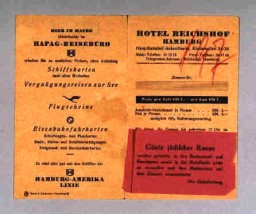
Artifact
Browse an alphabetical list of artifacts from the Holocaust and World War II. Each object tells a story about the history and demonstrates human experiences during the time period.
<< Previous | Displaying results 1-17 of 17 for "Artifact" | Next >>
-
Hana Mueller's concentration camp skirt
ArtifactHana Mueller altered this skirt issued to her in the Auschwitz concentration camp in 1944 by using the hem to make pockets.

-
Handkerchief carried by a young Hungarian Jewish girl on the Kasztner train
ArtifactA red and yellow floral handkerchief belonging to Judit Gondos that she took with her when she left Budapest on the Kasztner rescue train.

-
Hans Vogel's diary entry about receiving US immigration papers
ArtifactDiaries reveal some of the most intimate, heart-wrenching accounts of the Holocaust. They record in real time the feelings of loss, fear, and, sometimes, hope of those facing extraordinary peril. The diary of Hans Vogel, who fled Paris with his family while his father was interned, contains hand-drawn and colored maps of their flight. This page describes receiving papers allowing the family to immigrate to the United States. Hans was born in Cologne, Germany on December 3, 1926. The family left Germany…

-
Hans Vogel's diary entry describing the voyage to the United States
ArtifactHans Vogel and his family fled Paris following the German invasion. They eventually received papers allowing them to immigrate to the United States. During this time, Hans kept a diary that contains postcards, hand-drawn maps, and other illustrations of their flight. This page describes the voyage on board the Nyassa to the United States. Hans was born in Cologne, Germany on December 3, 1926. The family left Germany in 1936, settling in Paris. They remained there until the outbreak of World War II.…
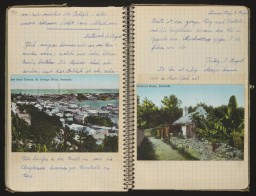
-
Hans Vogel's diary entry on arriving in New York
ArtifactHans Vogel and his family fled Paris following the German invasion. They eventually received papers allowing them to immigrate to the United States. During this time, Hans kept a diary that contains postcards, hand-drawn maps, and other illustrations of their flight. This page describes arriving in New York. Hans was born in Cologne, Germany on December 3, 1926. The family left Germany in 1936, settling in Paris. They remained there until the outbreak of World War II. Hans's father, Simon, was interned…
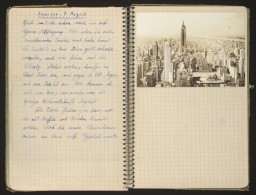
-
Hans Vogel's diary entry on boarding the refugee ship Nyassa
ArtifactHans Vogel and his family fled Paris following the German invasion. They eventually received papers allowing them to immigrate to the United States. During this time, Hans kept a diary that contains postcards, hand-drawn maps, and other illustrations of their flight. This page describes the lead-up to their departure for the United States, from Lisbon, on the Nyassa. Hans was born in Cologne, Germany on December 3, 1926. The family left Germany in 1936, settling in Paris. They remained there until the…

-
Hartheim Register
ArtifactOne of the primary documents used to calculate the number of deaths in the Nazi "euthanasia" program is this register discovered in a locked filing cabinet by US Army troops in 1945 at a killing site in Hartheim, Austria. The right page details by month the number of patients who were "disinfected" in 1940. The final column indicates that 35,224 persons had been put to death that year.

-
Headphones
ArtifactHeadphones used by defendant Hans Frank during the International Military Tribunal. Headphones like these enabled trial participants to hear simultaneous translation of the proceedings.
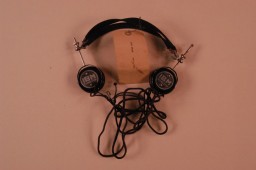
-
Headphones
ArtifactHeadphones used by defendant Hermann Göring during the International Military Tribunal. Headphones like these enabled trial participants to hear simultaneous translation of the proceedings.
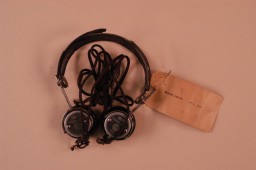
-
Headphones
ArtifactHeadphones used by defendant Albert Speer during the International Military Tribunal. Headphones like these enabled trial participants to hear simultaneous translation of the proceedings.

-
Hitler Youth knife and case
ArtifactHitler Youth knife and case shaped like a military bayonet, with the emblem of the Hitler Youth, emphasizing the paramilitary nature of the organization.

-
Hitler Youth poster
ArtifactPoster urging young Germans to join the Hitler Youth Landdienst [agricultural service]. It reads "Volunteers to the front! Youth to the land service of the Hitler Youth."
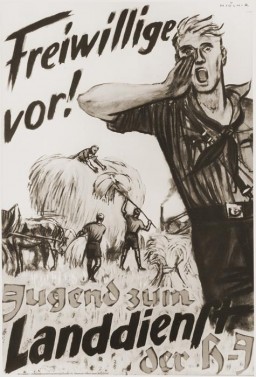
-
Hitler Youth proficiency badge
ArtifactThis Hitler Youth proficiency badge would have been awarded for the successful completion of a series of tests measuring physical and ideological proficiency. Success in these tests was rated according to criteria in the Hitler Youth identity document and performance book known as the Leistungsbuch. On this badge, the arrow shape (the tyr-rune) represents the warrior god Tyr. Beginning in 1933, the Hitler Youth and the League of German Girls had an important role to play in the new Nazi regime. Through…
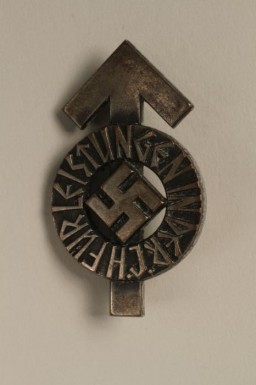
-
Hitler Youth uniform
ArtifactHitler Youth summer uniform jacket with an armband and insignia designating the regiment and district to which the member belonged. Beginning in 1933, the Hitler Youth and its organization for girls and young women, the League of German Girls, played an important role the new Nazi regime. Through these organizations, the Nazi regime indoctrinated young people with Nazi ideology, including antisemitism and racism. All prospective members of the Hitler Youth had to be "Aryans" and "genetically healthy."…
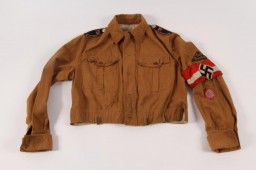
-
Hitler Youth "Youthfest" badge
ArtifactThis badge shows the Hitler Youth insignia and Nazi German national symbol superimposed over ring bearing the raised text, "Deutsches/Jugendfest 1936." Beginning in 1933, the Hitler Youth and the League of German Girls had an important role to play in the new Nazi regime. Through these organizations, the Nazi regime planned to indoctrinate young people with Nazi ideology. This was part of the process of Nazifying German society. The aim of this process was to dismantle existing social structures and…
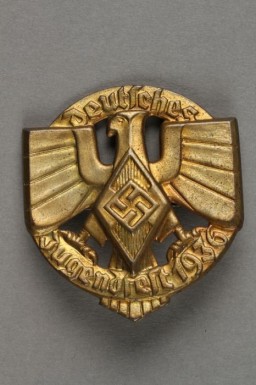
-
Hoess affidavit
ArtifactAffidavit signed by Rudolf Hoess attesting to the gassing of Jews while he was the commandant of the Auschwitz killing center. The German text reads: "I declare herewith under oath that in the years 1941 to 1943 during my tenure in office as commandant of Auschwitz Concentration Camp 2 million Jews were put to death by gassing and a 1/2 million by other means. Rudolf Hoess. May 14, 1946." The confession is also signed by Josef Maier of the US Chief of Counsel's office. A photoreproduction of the original…
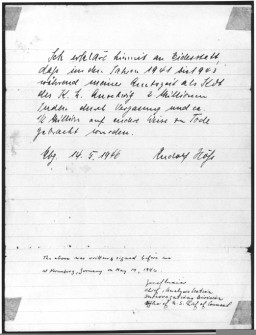
-
Hotel Reichshof flyer
Artifact1939 flyer from the Hotel Reichshof in Hamburg, Germany. The red tag informed Jewish guests of the hotel that they were not permitted in the hotel restaurant, bar, or in the reception rooms. The hotel management required Jewish guests to take their meals in their rooms. Following the Nuremberg Laws of 1935, Jews were systematically excluded from public places in Germany.
